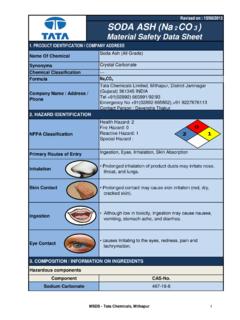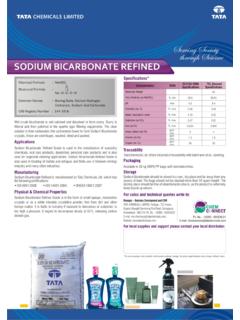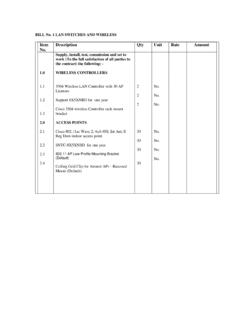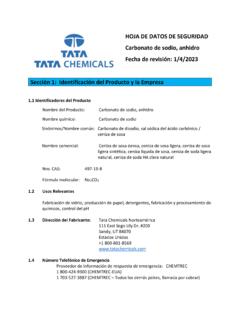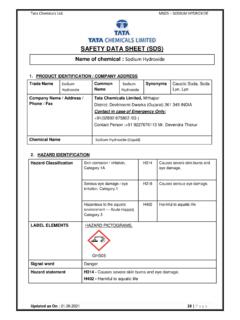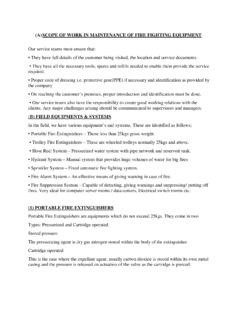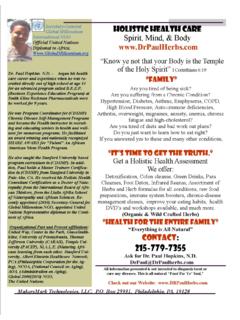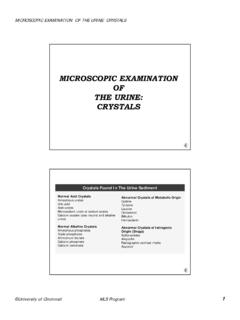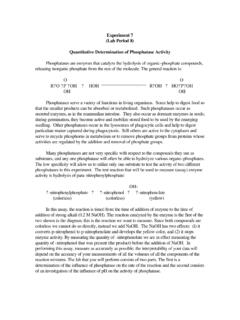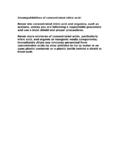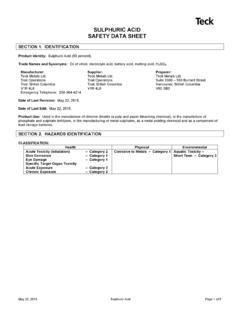Transcription of SAFETY DATA SHEET (SDS)
1 Tata Chemicals Ltd. MSDS HYDROCHLORIC acid Updated as On : 43 | P a g e SAFETY DATA SHEET (SDS) Name of chemical: Hydrochloric acid 1. PRODUCT IDENTIFICATION / COMPANY ADDRESS Trade Name Hydrochloric acid (HCl) aqueous all grades Common Name Hydrochloric acid Synonyms Muriatic acid , Chlorohydric acid , Spirit of Salt, Company Name / Address / Phone / Fax Tata Chemicals Limited, Mithapur District: Devbhoomi Dwarka (Gujarat) 361 345 INDIA Contact in case of Emergency Only: +91(02892 675802 /03 ) Contact Person :+91 9227676113 Mr.
2 Devendra Thakur Chemical Name Hydrochloric acid 2. HAZARD IDENTIFICATION Hazard Classification GHS: CONTACT HAZARD - SKIN Category 1B - Causes severe skin burns and eye damage. GHS: CONTACT HAZARD - EYE Category 1 - Causes serious eye damage GHS: ACUTE TOXICITY - INHALATION Category 4 - Harmful if inhaled GHS: ACUTE TOXICITY - ORAL Category 4 - Harmful if swallowed. GHS: TARGET ORGAN TOXICITY(REPEATED EXPOSURE) Category 1 - Causes damage to teeth through prolonged or repeated exposure GHS: TARGET ORGAN TOXICITY (REPEATED EXPOSURE) Category 1 - Causes damage to teeth through prolonged or repeated exposure GHS: CARCINOGENICITY: Not classified as a carcinogen per GHS criteria.
3 This material is not classifiable as to its carcinogenicity to humans (Group 3 - IARC). ACGIH - A4 Carcinogen - Not classifiable as a human carcinogen. Tata Chemicals Ltd. MSDS HYDROCHLORIC acid Updated as On : 44 | P a g e LABEL ELEMENTS HAZARD PICTOGRAMS. Signal word Danger Hazard statement Causes severe skin burns and eye damage Causes serious eye damage Harmful if swallowed Harmful if inhaled Causes damage to organs through prolonged or repeated exposure (teeth) Precautionary statement Wear protective gloves, protective clothing, eye, and face protection Do not breathe mist, vapours, or spray Wash thoroughly after handling Do not eat, drink or smoke when using this product Use only outdoors or in a well-ventilated area IF IN EYES.
4 Rinse cautiously with water for several minutes. Remove contact lenses, if present and easy to do. Continue rinsing IF ON SKIN (or hair): Remove/Take off immediately all contaminated clothing. Rinse SKIN with water/shower IF SWALLOWED : Rinse mouth. Do NOT induce vomiting Immediately call a POISON CENTER or doctor/physician Wash contaminated clothing before reuse IF INHALED: Remove person to fresh air and keep comfortable for breathing Call a POISON CENTER or doctor/physician if you feel unwell Specific treatment (see First Aid information on product label and/or Section 4 of the SDS 3.)
5 COMPOSITION / INFORMATION AND INGREDIENTS Structural Formula H-Cl Chemical Family acid Molecular weight CAS No 7647-01-0 (HCl) 7732-18-5 (H2O) Molecular Formula HCl Tata Chemicals Ltd. MSDS HYDROCHLORIC acid Updated as On : 45 | P a g e Name Product identifier % Classification Hydrogen chloride 7647-01-0 9-36% (HCl) 91 63% (H2O) Causes severe skin burns and eye damage Causes serious eye damage Harmful if swallowed Harmful if inhaled Causes damage to organs through prolonged or repeated exposure (teeth) 4. FIRST AID MEASURE Ingestion Do NOT induce vomiting.
6 If victim is conscious and alert, give 2-4 cup full of milk Consult a doctor immediately. Never give anything by mouth to an unconscious person. Inhalation Remove patient to fresh air. Administer approved oxygen supply if breathing is difficult. Administer artificial respiration or CPR if breathing has ceased. Get medical attention immediately. Eyes Immediately flush eyes with large amounts of water for at least 30 minutes, holding lids apart to ensure flushing of the entire surface. Get medical aid immediately.
7 Do NOT allow victim to rub eyes or keep eyes closed. Skin Immediately flush skin with copious quantities of water for at least 15 minutes while removing contaminated clothing and shoes. Cold water may be used. Get medical attention immediately. Antidote Tata Chemicals Ltd. MSDS HYDROCHLORIC acid Updated as On : 46 | P a g e Most important symptoms/ effects, acute and or delayed Eye Contact- May cause irreversible eye injury. Vapor or mist may cause irritation and severe burns. Contact with liquid is corrosive to the eyes and causes severe burns.
8 May cause conjunctivitis May cause permanent damage. Inhalation- Causes severe respiratory tract inflammation. Destructive to tissues of mucous membranes. Coughing, difficulty breathing, pulmonary edema, collapse, respiratory system and lung damage, possible coma and possibly death. Skin contact- May be absorbed through the skin in harmful amounts. Contact with liquid is corrosive and causes severe burns and ulceration. May cause photosensitization in certain individuals. Ingestion- May cause circulatory system failure. Can causes severe digestive tract burns with abdominal pain, vomiting, and possible death.
9 May cause corrosion and permanent tissue destruction of the esophagus and digestive tract. Indication of immediate medical attention and special treatment needed May aggravate pre-existing conditions such as: eye disorders that decrease tear production or have reduced integrity of the eye; skin disorders that compromise the integrity of the skin; and respiratory conditions including asthma and other breathing disorders. 5. FIRE FIGHTING MEASURES Fire extinguishing media Not applicable Hazardous decomposition products Hydrogen chloride, Chlorine, Hydrogen gas Special fire fighting procedure Non-flammable.
10 Precaution to Fire Fighters Use media suitable for surrounding materials. 6. ACCIDENTAL RELEASE MEASURES Personal precaution Use proper personal protective equipment as indicated in Section 8. Restrict access to affected area. Keep people away from and upwind of spill/leak. Precautions for the environment Keep out of water supplies and sewers. This material is acidic and may lower the pH of the surface waters with low buffering capacity. Releases should be reported, if required, to appropriate agencies. Clean up method Large spills may be neutralized with dilute alkaline solutions of soda ash, or lime.
